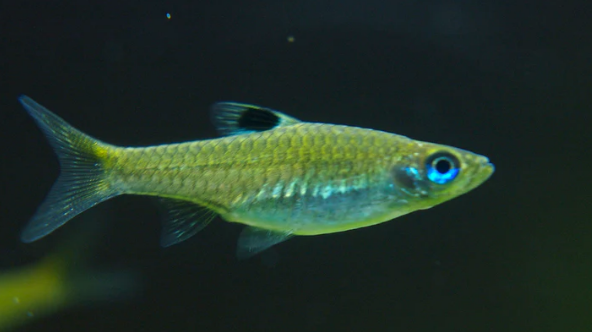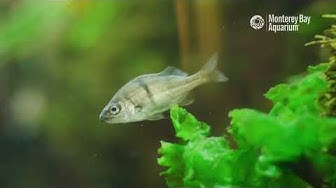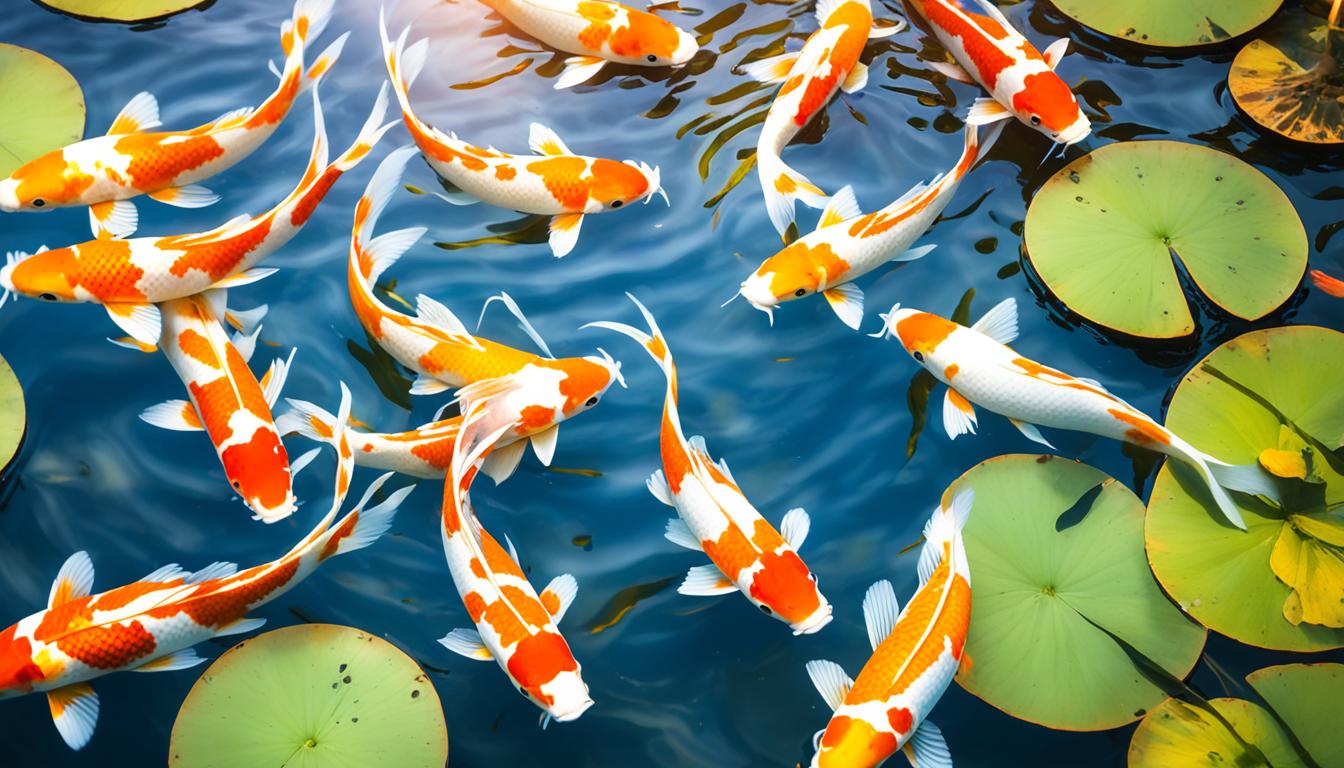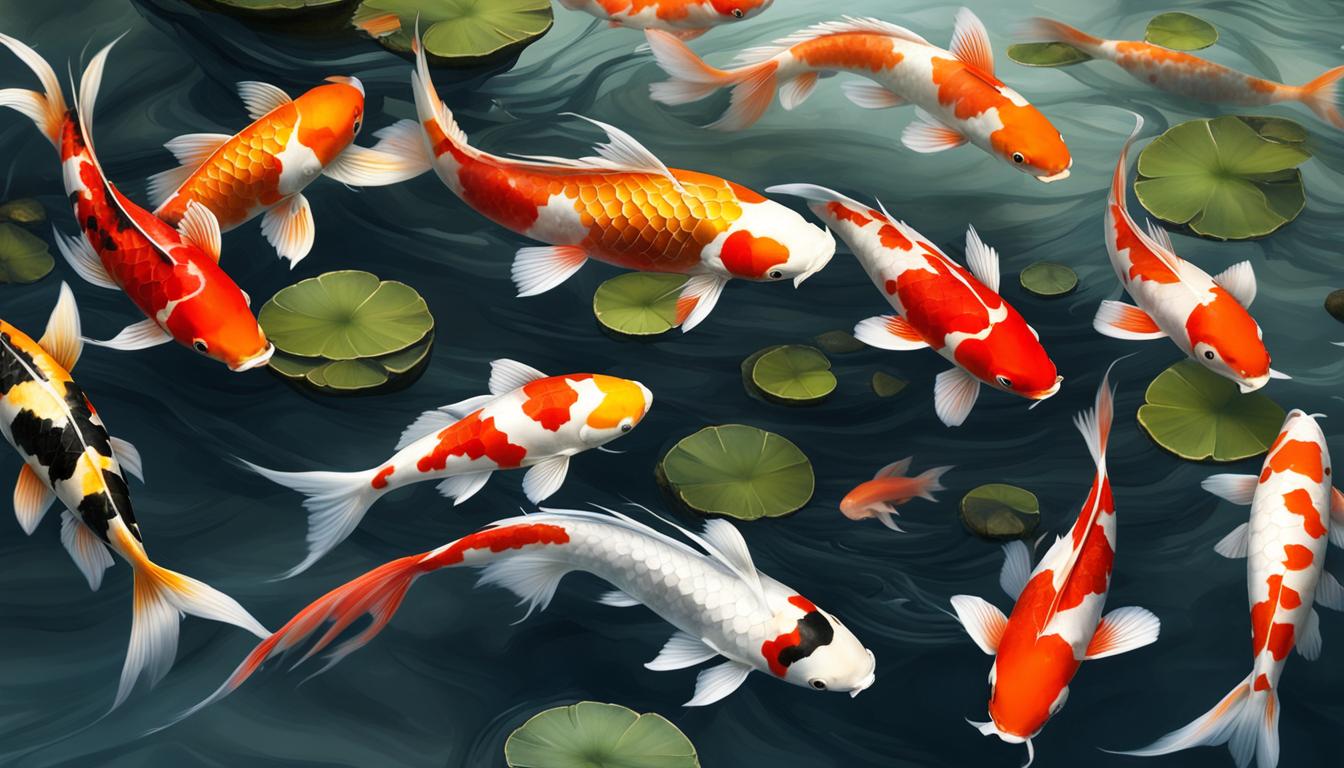The Green Eye Rasbora (Brevibora dorsiocellata) is a small freshwater fish with shiny green eyes. It is a peaceful schooling fish native to Southeast Asia and is relatively easy to care for.
These rasboras have an elongated body shape and a metallic silverish color. They are omnivores and can eat a variety of foods, including flakes, pellets, and live or frozen foods like brine shrimp. The Emerald Eye Rasbora is a beautiful species commonly found in the streams and tributaries of Asia.
It is a popular choice for aquarium enthusiasts due to its eye-catching green eyes and peaceful nature.

Table of Contents
Overview Of Green Eye Rasbora
| Attribute | Details |
|---|---|
| Scientific Name | Microdevario kubotai |
| Common Name | Green Eye Rasbora |
| Origin | Southeast Asia |
| Size | Up to 1.5 inches |
| Life Expectancy | 3-5 years |
| Different Colors | Green, Silver |
| Diet | Omnivore |
| Temperament | Peaceful |
| Tank Size | Minimum 10 gallons |
| Temperature | 68-78°F (20-26°C) |
| pH | 6.0-7.5 |
| Water Hardness Level | Soft to Medium |
| Care Level | Easy |
| Breeding Style | Egg scatterer |
| Compatible Fish | Small, peaceful species |
| Type of Tank Most Suitable | Planted Aquarium |
| Tank Mates | Tetras, Danios, Shrimps |
Key Takeaways:
- The Green Eye Rasbora is a stunning freshwater fish with a vibrant green eye stripe.
- It is a popular choice for nano tanks and community tanks due to its peaceful and adaptable nature.
- Creating a well-designed habitat with suitable tankmates is crucial for a harmonious Green Eye Rasbora community.
- Feeding the Green Eye Rasbora a varied diet and maintaining optimal water conditions are essential for its health and well-being.
- Shoaling fish, like the Green Eye Rasbora, can create a lively and dynamic aquatic environment in your aquarium.
Characteristics and Habitat of the Green Eye Rasbora
The Green Eye Rasbora, also known as Rasbora simonbirchi, is a fascinating freshwater fish. It’s from the middle Barito River Basin in Borneo, Southeast Asia. The fish lives in blackwater rivers and streams, which have soft, acidic water full of tannins and organic compounds. These conditions are perfect for the Green Eye Rasbora.
In its natural setting, the Green Eye Rasbora loves areas full of plants, leaves, branches, and twigs. This makes their environment vibrant and lush. To mimic this in an aquarium, aim for a river tank setup. Use gravel or rocks, plenty of aquatic plants, and driftwood. These elements provide security and comfort for the fish.
Keep a close eye on water parameters for the fish’s well-being. The ideal water temperature is between 73 and 79°F (22 and 26°C). The pH level should be slightly acidic to neutral, between 6.0 and 7.5. These conditions help the fish show off their beautiful colors.
Rasbora Care and Maintenance
Caring for the Green Eye Rasbora properly ensures its health and long life. Follow these important guidelines:
- Regularly test the water: Keep track of temperature, pH levels, ammonia, nitrite, and nitrate to maintain a healthy environment.
- Feed them well: Offer a mix of high-quality dry foods and live or frozen foods like bloodworms, brine shrimp, or daphnia for a balanced diet.
- Use good filtration and change water often: A proper filtration system and regular water changes help maintain water quality.
- Choose compatible tank mates: Make sure the Green Eye Rasbora’s tank mates have similar care needs to avoid stress or conflict.
- Watch and maintain: Look out for signs of illness or stress and keep the aquarium in good condition. This keeps the fish thriving.
By giving the Green Eye Rasbora the right care and a fitting habitat, you can create a beautiful setting for them. This lets them show their natural behaviors and bright colors.
Building a Harmonious Community with the Green Eye Rasbora
The Green Eye Rasbora is perfect for community tanks. It’s peaceful and not aggressive. This makes it great for new fish keepers. A group of six or more lets their colors shine, making your tank look amazing.
When adding friends for them, pick other peaceful fish. Good choices are Livebearers, Tetras, Gouramis, Rainbowfish, Catfish, and Loaches. They get along well with the Green Eye Rasbora, making a calm community.
But, stay away from aggressive or territorial fish. They can upset the peace and cause trouble among your Rasboras.
Choose the right companions and a peaceful setting. This will help your Green Eye Rasboras do well. They’ll add beauty and calm to your tank.
Tips for Breeding Green Eye Rasboras

Breeding Green Eye Rasboras can be hard since not much is known about how they breed. They are thought to scatter their eggs and spawn regularly.
To raise your chances of breeding them, set up a special tank. This tank needs dim light for the right breeding mood. It also needs a special bottom so eggs can drop through without being eaten.
It’s key to get the adult fish ready together. By feeding them well and adding cooler water, you mimic their natural spawning triggers. The temperature is very important for the eggs, which hatch in 18 to 48 hours.
After the eggs hatch, the tiny fish need good food to grow. Feed them things like Paramecium or infusoria. This helps them during their early life.
Tips for Breeding Green Eye Rasboras:
- Set up a separate breeding tank with dim lighting.
- Provide suitable substrate for the eggs to fall through.
- Condition the adult group together and gradually top up the tank with cooler water to simulate natural conditions and encourage spawning.
- Monitor temperature as it affects the incubation period of the eggs.
- Provide appropriate fry food like Paramecium or infusoria for the young rasboras.
By using these tips and creating the right conditions, you have a better chance at successfully breeding. Then, you can watch the baby Green Eye Rasbora fish grow in your tank.
Feeding and Care for Green Eye Rasboras
Green Eye Rasboras are easy to care for with flexible diets. They thrive well on quality dried foods. Flakes and pellets for small fish work great. Adding live or frozen foods like bloodworms and brine shrimp ensure a balanced diet.
Keeping the water clean and right is key to their health. Make sure to do regular water changes and check the filtration. Keeping an eye on water parameters keeps your fish healthy.
Dietary Needs of Green Eye Rasboras
Green Eye Rasboras are easygoing when it comes to food. They do well on a base diet of quality dried foods. Flakes and pellets provide them with needed nutrients.
But, a diet mixed with live or frozen foods is best for their health. Foods like bloodworms add essential proteins. This mix mirrors their natural diet, promoting health and color.
A varied diet is crucial. Mixing dried foods with live or frozen ones gives them everything they need. This makes them healthier and more vibrant.
Water Parameters and Maintenance
Good water quality is vital for Green Eye Rasboras. They do best in stable freshwater environments.
Here’s what you need to know for their care:
- Temperature: They like temperatures between 73 – 79°F (22 – 26°C), typical for tropical fish.
- pH Level: Keep the pH slightly acidic to neutral, between 6.0 – 7.5. Regular checks and adjustments will keep the water just right.
- Water Hardness: They can handle various water hardness levels. But 5 – 12 dGH is ideal for their health.
- Water Filtration: Choose a suitable filtration system for your tank size. Keeping your filter clean ensures good water quality.
- Water Changes: Change about 20% of the water every 1 – 2 weeks. It removes toxins and keeps water stable.
Following these steps will help you provide a healthy home for your Green Eye Rasboras. They’ll be happier and live longer in the right conditions.
The Enchantment of Shoaling Fish
Shoaling fish love to hang out together but not in a tight group. They don’t move in sync like schooling fish. But being in a group makes them feel safe and gives them pals. Having them in your aquarium makes things fun and lively. They search for food, play tag, and sometimes move together. Green Eye Rasboras are perfect for bringing this magic into your tank.
Understanding why shoaling fish stick together is key to enjoying them. It makes your aquarium look better and more peaceful. Watching them move together is calming and beautiful. It brings a piece of nature into your home.
Green Eye Rasboras are peaceful and look amazing. They have a green stripe and pretty fins. If you have at least six, they show off their best colors. They play well with other fish, making your tank look vibrant.
But, setting up a tank for Green Eye Rasboras needs some thought. You need the right tank size and other peaceful fish. Make sure there’s enough room to swim and places for them to hide.
Benefits of Shoaling Fish in the Aquarium Community
Adding shoaling fish like Green Eye Rasboras has many pluses:
- Sociability and Companionship: They make the tank friendly. This reduces stress for all the fish.
- Improved Foraging and Feeding: They find food together, making sure everyone eats.
- Natural Behavior and Aesthetic Appeal: Their synchronized swimming is beautiful and natural.
- Enhanced Tank Dynamics: They add excitement and beauty to your tank.
With Green Eye Rasboras and friends, your tank will be a beautiful, lively place. You’ll enjoy watching this social underwater world. It’s a great way to have a piece of the ocean in your home.
| Advantages of Shoaling Fish in the Aquarium | Disadvantages of Shoaling Fish in the Aquarium |
|---|---|
| Enhanced social interaction among fish species | Increased competition for resources |
| Improved feeding efficiency and foraging behavior | Potential for overcrowding in small tanks |
| Increased visual appeal and activity in the tank | Possible aggression or territorial behavior |
| Creation of a more natural and dynamic environment | Higher risk of disease transmission within the group |
Creating a Shoaling Community with Green Eye Rasboras

Green Eye Rasboras need to be in groups of at least six. With more fish, their colors shine brighter and they feel safer. It’s important to have a big, well-set tank with lots of space to swim and hide.
Adding other friendly fish like Neon Tetras, Rasboras, and Cherry Barbs makes the tank look better. These fish also make the community more dynamic.
Choosing tank-mates that are easy to care for and get along well is key for peace among the fish. This way, you can have a beautiful and lively aquarium that shows how these fish naturally behave together.
Building a community with Green Eye Rasboras and other calm fish is rewarding. You’ll love watching their bright colors and peaceful ways. Plus, you’ll see how beautifully they live together in your tank.
Essential Care for Shoaling Fish
When you have shoaling fish, you need to think about several things. These include the tank’s setup, keeping the water clean, what they eat, and if they get along with other fish. By focusing on these areas, you make sure your fish stay healthy and happy.
Tank Setup
Creating a good space for your shoaling fish is key. They need lots of room to swim and places to hide. Adding things like live plants and driftwood makes their home look nice and gives them spots to relax.
Water Quality
Keeping the water perfect is critical for shoaling fish. You should change the water often, use a good filter, and keep an eye on water conditions. Clean, oxygen-rich water is what these fish love, so staying on top of their home’s upkeep is a must.
Diet and Feeding
Shoaling fish aren’t too picky with food, but they need a mix to stay healthy. Dried foods like flakes or pellets are great for everyday meals. But, adding live or frozen snacks like bloodworms or brine shrimp is important too. These treats give them the extra nutrients they crave.
Compatibility
When adding new fish, think about if they’ll fit in well. You want peaceful fish that need similar things and get along with everyone. Asking experts and doing some research can guide you to the best choices for your tankmates.
In short, caring for shoaling fish means setting up their tank the right way, keeping their water clean, feeding them a varied diet, and picking the right friends for them. Doing these things will help you create a beautiful and healthy fish community.
Exploring the Diversity of Shoaling Fish
If you love aquariums, there’s a lot of shoaling fish to check out. Neon Tetras, Rasboras, Ember Tetras, Celestial Pearl Danios, and Glowlight Tetras are popular. They have bright colors and move together closely. This makes your tank look lively. Each fish type is special in its way but all of them like being with others. This makes them great for any group of fish.
| Shoaling Fish Species | Main Characteristics |
|---|---|
| Neon Tetras | Small, colorful fish with a signature neon blue stripe along their body. They are peaceful and thrive in groups. |
| Rasboras | A diverse group of fish known for their vibrant colors and peaceful temperament. Popular rasbora species include the Harlequin Rasbora and Green Eye Rasbora. |
| Ember Tetras | These tiny tetras feature a striking orange-red coloration that adds a bold splash of color to the aquarium. They prefer heavily planted tanks. |
| Celestial Pearl Danios | A small, peaceful fish with shimmering pearl-like spots. They are excellent for nano tanks and prefer densely planted setups. |
| Glowlight Tetras | These tetras exhibit a vibrant orange-red body with an iridescent stripe running horizontally. They are peaceful and active swimmers. |
Choosing the Right Shoaling Fish for Your Aquarium
Choosing the right shoaling fish needs some thought. Think about how they get along with others, tank size, and water needs. Make sure they have enough room to swim and places to hide. Also, pick fish that get along well. It’s important to know what each fish type needs. This helps them stay healthy and happy in your tank.
Enhancing the Aquatic Experience with Shoaling Fish
I love the aquarium hobby and have discovered that exploring online can greatly improve it. YouTube videos about aquarium fish, shrimp, and snails are a great resource. They offer lots of tips, advice, and ideas for both new and experienced hobbyists.
Adding shoaling fish to your aquarium creates a lively community. These videos show the beauty and care of shoaling fish. They also explain how to set up your tank and which fish get along.
If you want to create a peaceful fish community or add colorful fish like neon tetras, these videos are a great help. They allow you to see how different shoaling fish behave and interact.
Why Watch Aquarium Videos?
Aquarium videos inspire creativity in tank design and aquascaping. They show many ways to create a stunning underwater world. From planted tanks to schooling fish, the possibilities are endless.
These videos also let aquarists share what they know. You can learn from their successes and avoid mistakes. This means better care for your shoaling fish.
Benefits of Aquarium Video Collections
Aquarium videos are educational and build a strong hobby community. They allow you to connect with other enthusiasts. You can share ideas and learn from others through comments.
They are also a great way to stay informed. As the hobby grows, videos introduce new techniques and species. They keep you up-to-date with the latest trends.
| Benefits of Aquarium Video Collections: |
|---|
| A source of inspiration for tank design and aquascape |
| Insights into the behaviors and interactions of shoaling fish |
| Learning from the experiences of fellow hobbyists |
| Access to accurate and up-to-date information |
| A platform for engagement and community building |
Whether you’re a seasoned aquarist or a beginner, aquarium videos can improve your hobby. They introduce you to the underwater world. Let your imagination explore!
Conclusion
The Green Eye Rasbora is a stunning and peaceful fish that adds tranquility and beauty to any aquarium. It is perfect for both beginners and experienced fish keepers. You can create a beautiful shoaling community with Green Eye Rasboras and other compatible fish.
To keep your Green Eye Rasboras healthy, provide them with a good home, proper care, and the right food. Step into the enchanting world of the Green Eye Rasbora. You’ll enjoy making a friendly and beautiful aquarium community.
FAQ
What is the maximum size of a Green Eye Rasbora?
A Green Eye Rasbora can grow to be about 10 cm long.
Can Green Eye Rasboras be kept in nano tanks?
Yes. Because of their small size, Green Eye Rasboras are great for nano tanks.
Are Green Eye Rasboras peaceful fish?
Yes, they are peaceful. They get along well with other friendly fish.
Can Green Eye Rasboras be kept in community tanks?
Absolutely. Green Eye Rasboras fit well in community tanks with various fish species.
What type of water conditions do Green Eye Rasboras prefer?
Green Eye Rasboras like soft, acidic water. The pH should be between 6.0 and 7.5.
Their ideal temperature is between 73 and 79°F (22 – 26°C).
How can I create a suitable habitat for Green Eye Rasboras?
To create a good home, use gravel or rocks. Add lots of plants and driftwood too.
This setup imitates their natural river habitat.
What are some suitable tankmates for Green Eye Rasboras?
Good tankmates include Livebearers, Tetras, and Gouramis. Rainbowfish, Catfish, and Loaches also suit them.
How can I breed Green Eye Rasboras?
Breeding them is tough. A separate tank with the right conditions can help.
Provide the fry with the right food to increase breeding success.
What do Green Eye Rasboras eat?
They do well on flakes and pellets. However, adding live foods like bloodworms is best.
This includes tubifex, brine shrimp, and daphnia.
How should shoaling fish be kept in the aquarium?
Shoaling fish should be in groups of six or more. They need space to swim and hide.
Ensure the aquarium is well-established for them.
What factors should I consider for optimal care of shoaling fish?
Consider a well-planned tank, clean water, and a mixed diet for their care.
What are some popular shoaling fish species?
Popular ones include Neon Tetras and Rasboras. Ember Tetras, Celestial Pearl Danios, and Glowlight Tetras are great too.
References
- International Federation of Online Clubs and Aquatic Societies (IFOCAS)
- Federation of British Aquatic Societies (FBAS)
- Northeast Council of Aquarium Societies (NEC)
- Federation of American Aquarium Societies (FAAS)
- Ornamental Aquatic Trade Association (OATA)
I am a passionate aquarist with over 30 years of hands-on experience in fishkeeping. My journey began at a young age, collecting fish from the wild and learning through experimentation. Specializing in tropical fish, I bring a deep understanding of the hobby to FishKeepingMadeSimple. The site provides honest, detailed reviews of essential products and accessories to help fellow enthusiasts create the best environments for their fish.









